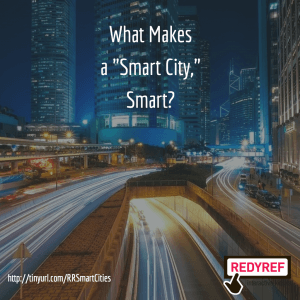If you asked ten people to define what “smart cities” are, you’d probably get 10 different answers. That’s partially because the idea of a truly intelligent city is still so relatively new. It’s also because it depends much on who is being asked.
For example, a smart city, to a city manager, may mean one that is connected and able to collect and transmit data about a variety of different subjects, from real-time reporting of environmental information (pollution) to traffic initiatives (red light cameras, speed zones) to the statuses of trains and buses within the public transportation system.
However, a city resident might define smart cities more simply as those that have deployed interactive kiosks that provide wayfinding and public wifi access. But ask the mayor, and she may consider a smart city to be one that has integrated aspects of e-governance, including enhanced communication with residents and streamlined access to city services.

What factors create a smart city?
Beyond the personal definitions of participants and adopters of smart city technology, there is actually some agreement in the academic community about what makes smart cities, “smart.” And while it is still fairly broad, it does provide a basic framework from which many urban planners are operating. According to an article in the Journal of Intelligent Buildings International: From Intelligent Cities to Smart Cities by Deakin & Al Waer, there are four factors that are of particular importance:
- The application of a wide range of electronic and digital technologies to communities and cities
- The use of Information and Communications Technologies (ICTs) to transform life and working environments within the region
- The embedding of such ICTs in government systems
- The territorialization of practices that bring ICTs and people together to enhance the innovation and knowledge that they offer.
In simpler terms: Smart cities integrate technology into government systems to enhance the quality of life of people working and/or living in the region, ultimately helping bring them together so they may more easily share knowledge.
Interactive kiosks are one way in which many regions are choosing to roll out smart city programs.
How? Come back soon and find out in our next blog! And If you’ve already decided interactive kiosks are the solution you’ve been looking for, contact RedyRef today at (800) 628-3603 or request a quote online and we’ll be with you every step of the way to ensure that your smart city kiosk deployment meets every one of your unique needs and goals.

